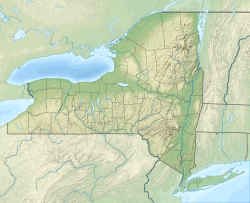| Bertie Formation | |
|---|---|
| Stratigraphic range: Pridoli (Cayugan Series) ~ | |
| Type | Geological group |
| Unit of | Cayugan Series |
| Sub-units | Falkirk (dolomite), Scajaquada (shale) and Williamsville (dolomite) - Western New York Fiddlers Green (dolomite), Forge Hollow (shale) and Oxbow (dolomite) - Central New York |
| Underlies | Bois Blanc Formation, Hederberg Group , Bass Islands Group |
| Overlies | Salina Group |
| Thickness | Up to 495 ft (151 m) |
| Lithology | |
| Primary | Dolomite, Shale |
| Other | Shale |
| Location | |
| Coordinates | 42°54′N 78°54′W / 42.9°N 78.9°W |
| Approximate paleocoordinates | 30°18′S 40°48′W / 30.3°S 40.8°W |
| Region | Ontario New York |
| Country | |
| Extent | Appalachian Basin |
| Type section | |
| Named for | Bertie, Ontario |
| Named by | Chapman |
| Year defined | 1864 |
The Bertie Group or Bertie Limestone, also referred to as the Bertie Dolomite and the Bertie Formation, is an upper Silurian (Pridoli, or Cayugan) geologic group and Lagerstätte in southern Ontario, Canada, and western New York State, United States. Details of the type locality and of stratigraphic nomenclature for this unit as used by the U.S. Geological Survey are available on-line at the National Geologic Map Database.[1] The formation comprises dolomites, limestones and shales and reaches a thickness of 495 feet (151 m) in the subsurface, while in outcrop the group can be 60 feet (18 m) thick.
The group represents the uppermost unit of the Cayugan Series and the youngest Silurian unit in Ontario. The group overlies the Salina Group and is conformably overlain by the Devonian Bois Blanc Formation in Ontario and Onondaga Limestone in New York.
Two formations within the Bertie Group, the Fiddler's Green and Williamsville, are considered Konservat-Lagerstätten; geologic units that contain a unique and typically soft-bodied fauna. These formations have produced thousands of Silurian eurypterids (sea scorpions) as well as early scorpion Proscorpius osborni, xiphosurans, primitive fossil flora, the planktonic cephalodiscid Rotaciurca superbus and the fish Nerepisacanthus denisoni. The excellent preservation of the many eurypterids and other taxa was the possibly result of periodic hypersaline and anoxic conditions owing to the group's position within a shallow inland sea (the Appalachian basin).

